FreeTail EVOKE Pro SDXC UHS-II Memory Card Capsule Review
by Ganesh T S on November 13, 2017 11:00 AM EST
Digital cameras and camcorders employ memory cards (flash-based removable media) for storage of captured content. There are different varieties of memory cards catering to various performance levels. CompactFlash (CF) became popular in the late 90s, but, has now been overtaken by Secure Digital (SD) cards. Many computing systems (PCs as well as smartphones) also support SD cards for augmenting local storage capabilities. We recently started in-depth evaluation of the performance of various memory cards. FreeTail sent over their UHS-II card for inclusion in our performance database.
Introduction
We looked at some of the CF cards in the EVOKE series from FreeTail Tech back in June. FreeTail also markets various other memory cards under this tag. Today's review looks at the FreeTail EVOKE Pro 1000x SDX UHS-II card.
SD (Secure Digital) cards were introduced in 1999, as an update to the existing MultiMediaCards (MMCs). It gained traction even in areas where CompactFlash had been preferred, thanks to its small size. Its popularity is evident by the fact that it has spawned two follow-ups in the same form factor - starting with the SDSC in 1999 for capacities between 1MB and 2GB, we got SD High Capacity (SDHC) in 2006 (up to 32GB) and SD eXtended Capacity (SDXC) in 2009 (up to 2TB). The cards also come in various sizes - standard, mini, and micro. In addition to the capacity aspect, the performance levels have also gone up. While UHS-I had an upper theoretical limit of around 100 MBps, UHS-II added more pins and increased the theoretical limit to around 312 MBps.
FreeTail's SDXC UHS-II/U3 lineup comes under the EVOKE Pro category, and has three members - 64GB, 128GB, and 256GB. Today's review takes a look at the 128GB version
Testbed Setup and Testing Methodology
Evaluation of memory cards is done on Windows with the testbed outlined in the table below. The USB 3.1 Type-C port enabled by the Intel Alpine Ridge controller is used for benchmarking purposes on the testbed side. It connects to the Z170 PCH via a PCIe 3.0 x4 link. SD cards utilize the Lexar Professional Workflow SR2 SDHC / SDXC UHS-II USB 3.0 Reader. The reader was placed in the Lexar Professional Workflow HR2 hub and uplinked through its USB 3.0 port with the help of a USB 3.0 Type-A female to Type-C male cable.
| AnandTech DAS Testbed Configuration | |
| Motherboard | GIGABYTE Z170X-UD5 TH ATX |
| CPU | Intel Core i5-6600K |
| Memory | G.Skill Ripjaws 4 F4-2133C15-8GRR 32 GB ( 4x 8GB) DDR4-2133 @ 15-15-15-35 |
| OS Drive | Samsung SM951 MZVPV256 NVMe 256 GB |
| SATA Devices | Corsair Neutron XT SSD 480 GB Intel SSD 730 Series 480 GB |
| Add-on Card | None |
| Chassis | Cooler Master HAF XB EVO |
| PSU | Cooler Master V750 750 W |
| OS | Windows 10 Pro x64 |
| Thanks to Cooler Master, GIGABYTE, G.Skill and Intel for the build components | |
The full details of the reasoning behind choosing the above build components can be found here.
Sequential Accesses
FreeTail claims speeds of up to 240 MBps, but real-world speeds are bound to be lower. In fact, writes can sometimes be much slower. That said, a V60 rating is also claimed, indicating that a minimum sustained 60 MBps write rate can be expected. For most applications, these claimed numbers don't really matter as long as the card is capable of sustaining the maximum possible rate at which the camera it is used in dumps data. We use fio workloads to emulate typical camera recording conditions. We run the workload on a fresh card, and also after simulating extended usage. Instantaneous bandwidth numbers are graphed. This gives an idea of performance consistency (whether there is appreciable degradation in performance as the amount of pre-existing data increases and / or the card is subject to wear and tear in terms of amount and type of NAND writes). Further justification and details of the testing parameters are available here.
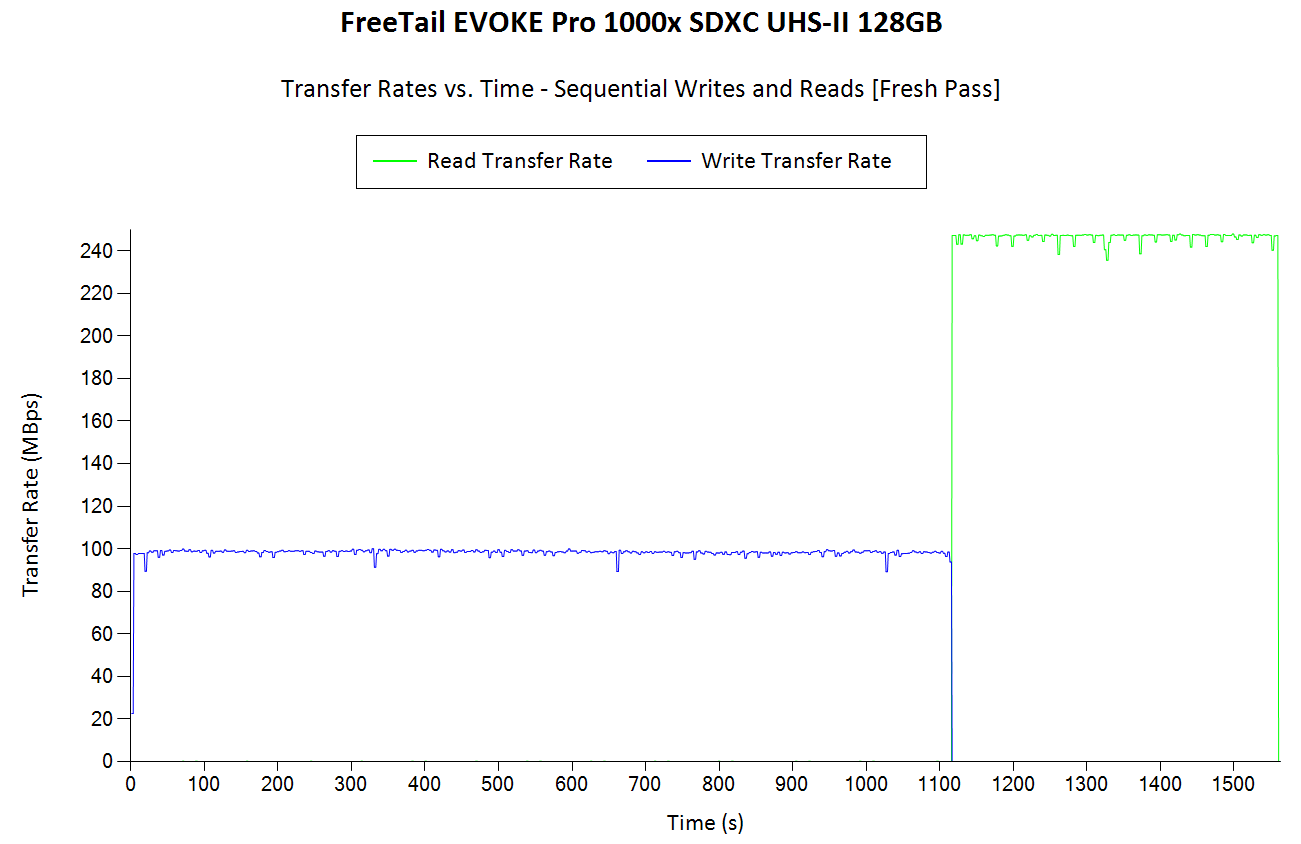
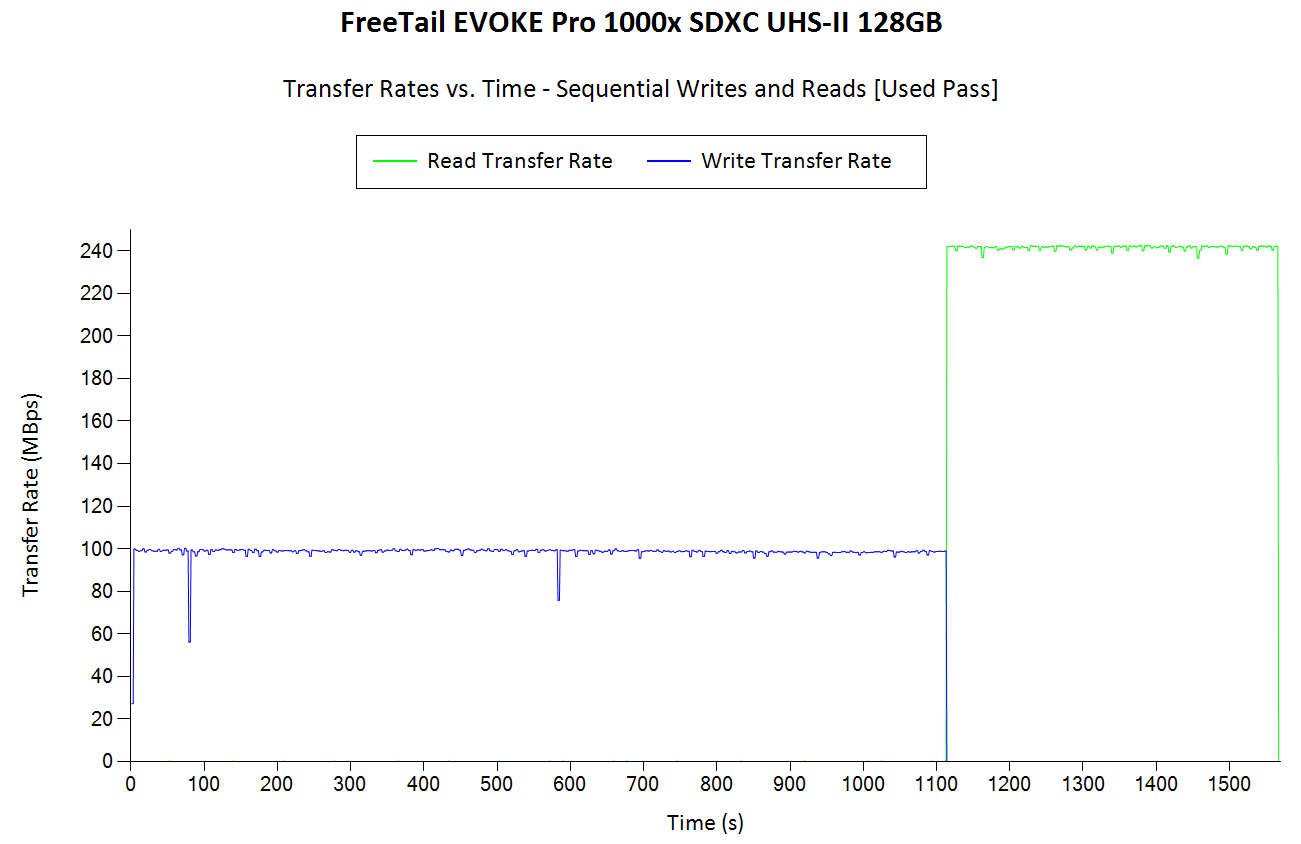
There is not much difference in the actual rate between the fresh and the used passes. In the latter, the writes sometimes dip to around 60 MBps, but, on the whole, the consistency is remarkable when compared to some of the other cards in our performance database.
AnandTech DAS Suite - Performance Consistency
The AnandTech DAS Suite involves transferring large amounts of photos and videos to and from the storage device using robocopy. This is followed by selected workloads from PCMark 8's storage benchmark in order to evaluate scenarios such as importing media files directly into multimedia editing programs such as Adobe Photoshop. Details of these tests from the perspective of memory cards are available here.
In this subsection, we deal with performance consistency while processing the robocopy segment. The graph below shows the read and write transfer rates to the memory card while the robocopy processes took place in the background. The data for writing to the card resides in a RAM drive in the testbed. The first three sets of writes and reads correspond to the photos suite. A small gap (for the transfer of the videos suite from the primary drive to the RAM drive) is followed by three sets for the next data set. Another small RAM-drive transfer gap is followed by three sets for the Blu-ray folder. The corresponding graphs for similar cards that we have evaluated before is available via the drop-down selection.
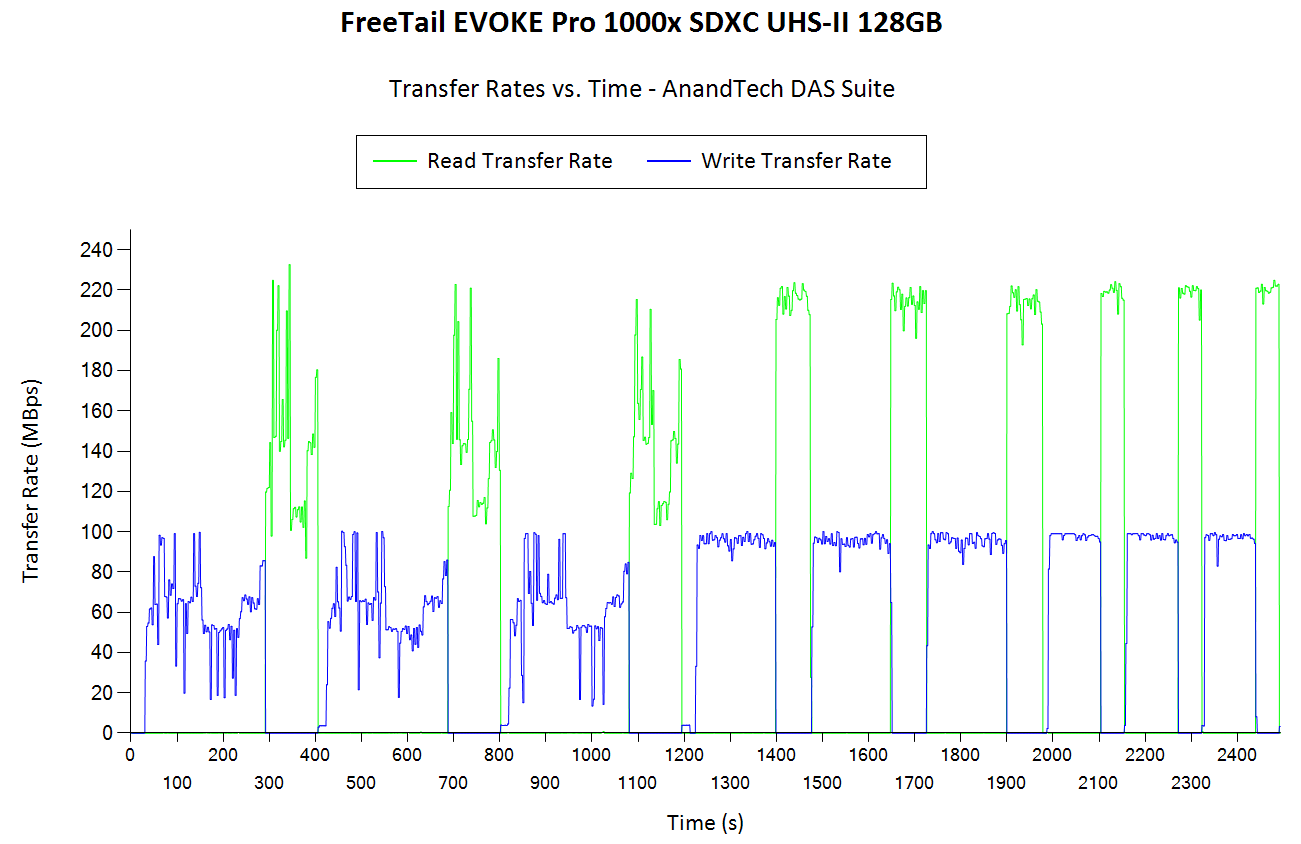
Small files tend to bring down the write rates, but, that is typical of almost all memory cards. The important takeaway here is that there is no consistency issue between two passes for the same data.
AnandTech DAS Suite - Bandwidth
The average transfer rates for each workload from the previous section is graphed below. Readers can get a quantitative number to compare the FreeTail EVOKE Pro SDXC UHS-II 128GB SD card against the ones that we have evaluated before.
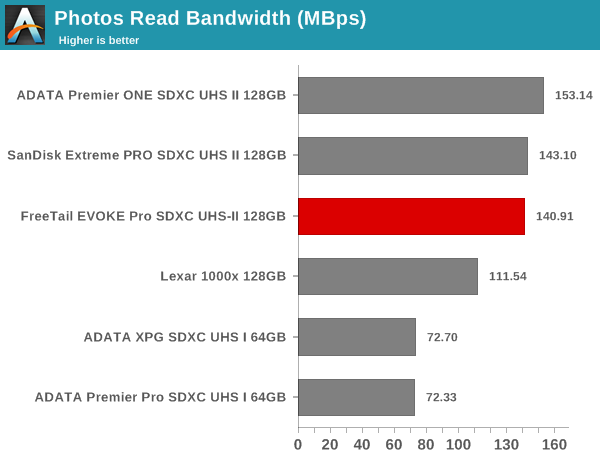
We see that the performance is quite predictable. The FreeTail EVOKE Pro matches the SanDisk Extreme Pro, while letting the ADATA Premier ONE lead the pack in the read workloads. In the write workloads, it comes behind those two, but, comfortably surpasses all the UHS-I cards in our database.
We also look at the PCMark 8 storage bench numbers in the graphs below. Note that the bandwidth number reported in the results don't involve idle time compression. Results might appear low, but that is part of the workload characteristic. Note that the same testbed is being used for all memory cards. Therefore, comparing the numbers for each trace should be possible across different cards. PCMark workloads are sometimes skewed by caching effects, but, in general, we see the trend from the robocopy benchmarks being repeated here.

Performance Restoration
The traditional memory card use-case is to delete the files on it after the import process is completed. Some prefer to format the card either using the PC, or, through the options available in the camera menu. The first option is not a great one, given that flash-based storage devices run into bandwidth issues if garbage collection (processes such as TRIM) is not run regularly. Different memory cards have different ways to bring them to a fresh state.Based on our experience, SD cards have to be formatted using the SD Formatter tool from the SD Association (after all the partitions are removed using the 'clean' command in diskpart).
In order to test out the effectiveness of the performance restoration process, we run the default sequential workloads in CrystalDiskMark before and after the formatting. Note that this is at the end of all our benchmark runs, and the card is in a used state at the beginning of the process. The corresponding screenshots for similar cards that we have evaluated before is available via the drop-down selection.

We do not see much difference between the used and refreshed cases, but, as we noted earlier, the performance loss in the used state is minimal.
Concluding Remarks
The FreeTail EVOKE Pro 1000x SDXC UHS-II card successfully completed our intensive benchmarking routines. It showed great performance consistency, but, only emerged as an average performer with respect to the raw benchmark numbers. In addition to raw performance and consistency, pricing is also an important aspect. This is particularly important in the casual user and semi-professional markets, where the value for money metric often trumps benchmark numbers.
The table below presents the relevant data for the FreeTail EVOKE Pro SDXC UHS-II 128GB SD card and other similar ones that we have evaluated before. The cards are ordered by the $/GB metric.
| SD Cards - Pricing | ||||
| Card | Model Number | Capacity (GB) | Street Price (USD) | Price per GB (USD/GB) |
| ADATA Premier Pro SDXC UHS I 64GB | ASDX64GUI3CL10-R | 64 | 41 | 0.64 |
| FreeTail EVOKE Pro SDXC UHS-II 128GB | FTSD128A10 | 128 | 95 | 0.74 |
| ADATA XPG SDXC UHS I 64GB | ASDX64GXUI3CL10-R | 64 | 80 | 1.25 |
| Lexar 1000x 128GB | LSD128CRBNA1000 | 128 | 170 | 1.33 |
| ADATA Premier ONE SDXC UHS II 128GB | ASDX128GUII3CL10-C | 128 | 206 | 1.61 |
| SanDisk Extreme PRO SDXC UHS II 128GB | SDSDXPK-128G-ANCIN | 128 | 250 | 1.95 |
The FreeTail card has the least price of all the UHS-II cards that we have evaluated so far - both in terms of $/GB and actual pricing. Based on the data in hand, we have no qualms in recommending the FreeTail EVOKE Pro SDXC UHS-II 128GB card to cost-conscious consumers. Out of all the cards that we have evaluated, it has the best balance of performance and cost.


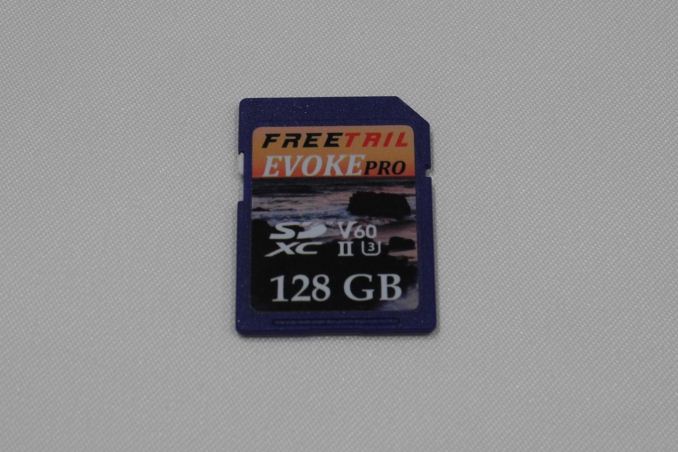








2 Comments
View All Comments
peevee - Monday, November 13, 2017 - link
The conclusion should really be like this:Whether or not this card is going to be good for you depends on you application. For example, if you shoot sports on your still camera, the only metric which really matters (affecting your buffer clearing rate and often maximum numbers of shots you can take) is write speed - and in this metric the card is 2 times slower than Adata ONE or SanDisk Extreme Pro.
If you shoot video, make sure the write speed is enough for your bitrate, although 100MBps should be enough even for 4k 10-bit in good quality (but maybe not for 6k/8k on upcoming cameras).
janvisingh11394 - Monday, August 19, 2019 - link
https://freeseptembercalendar.com/https://freeseptember2018calendar.info/september-2...